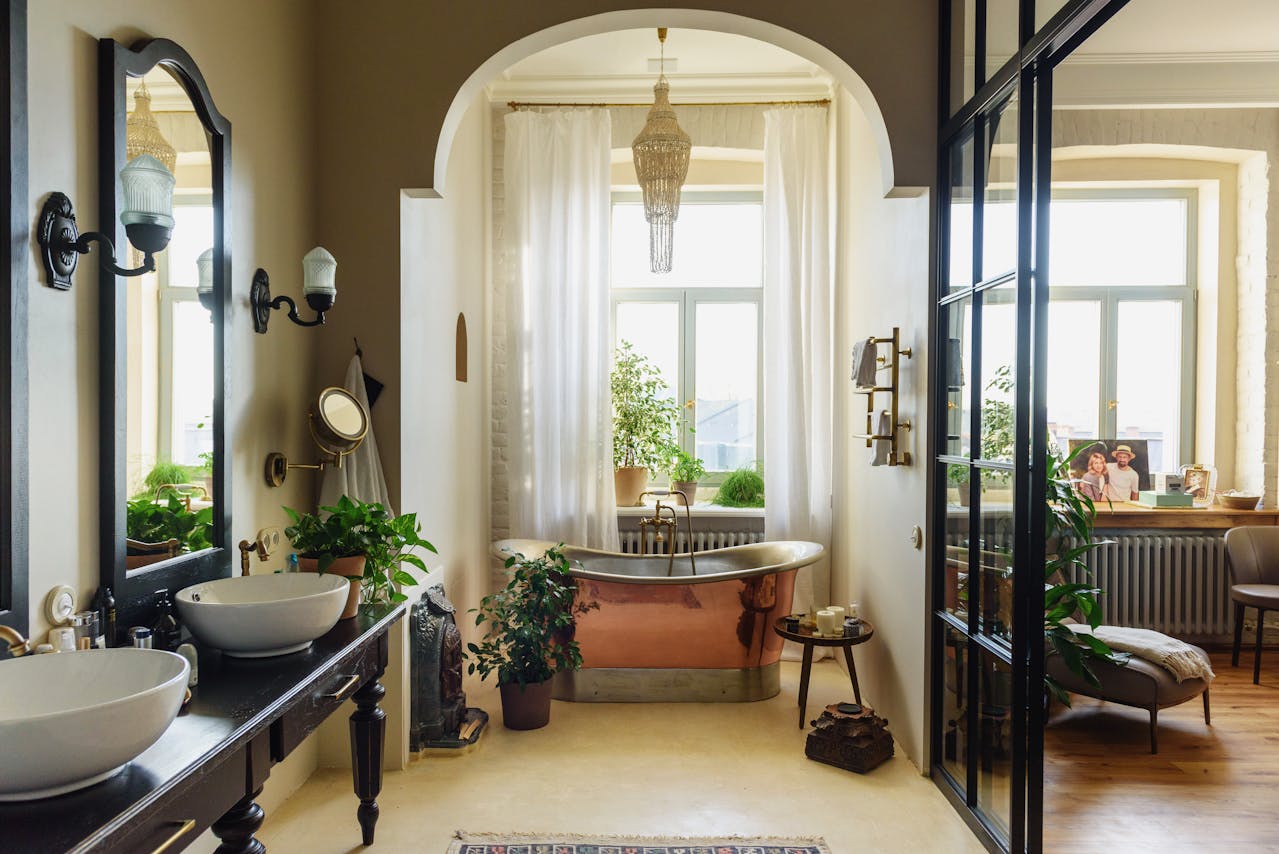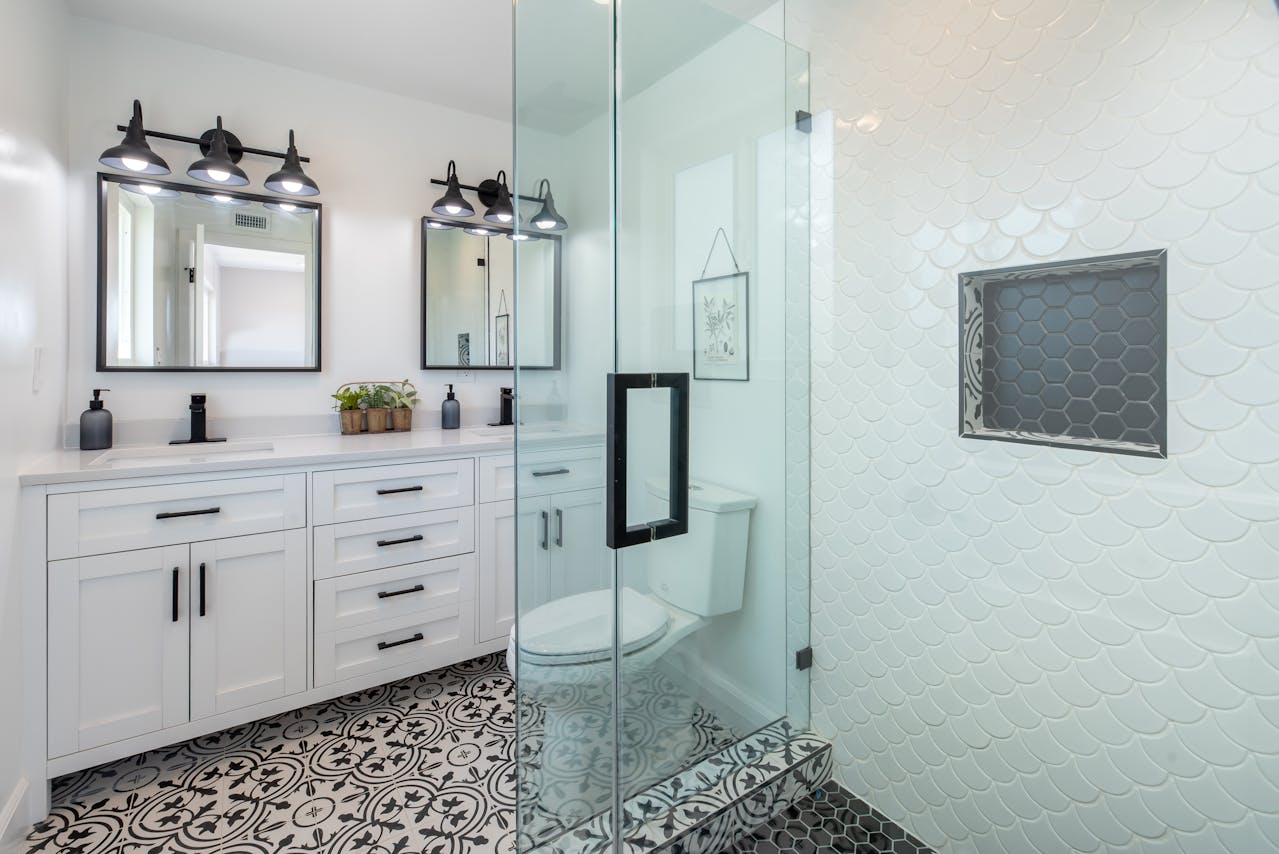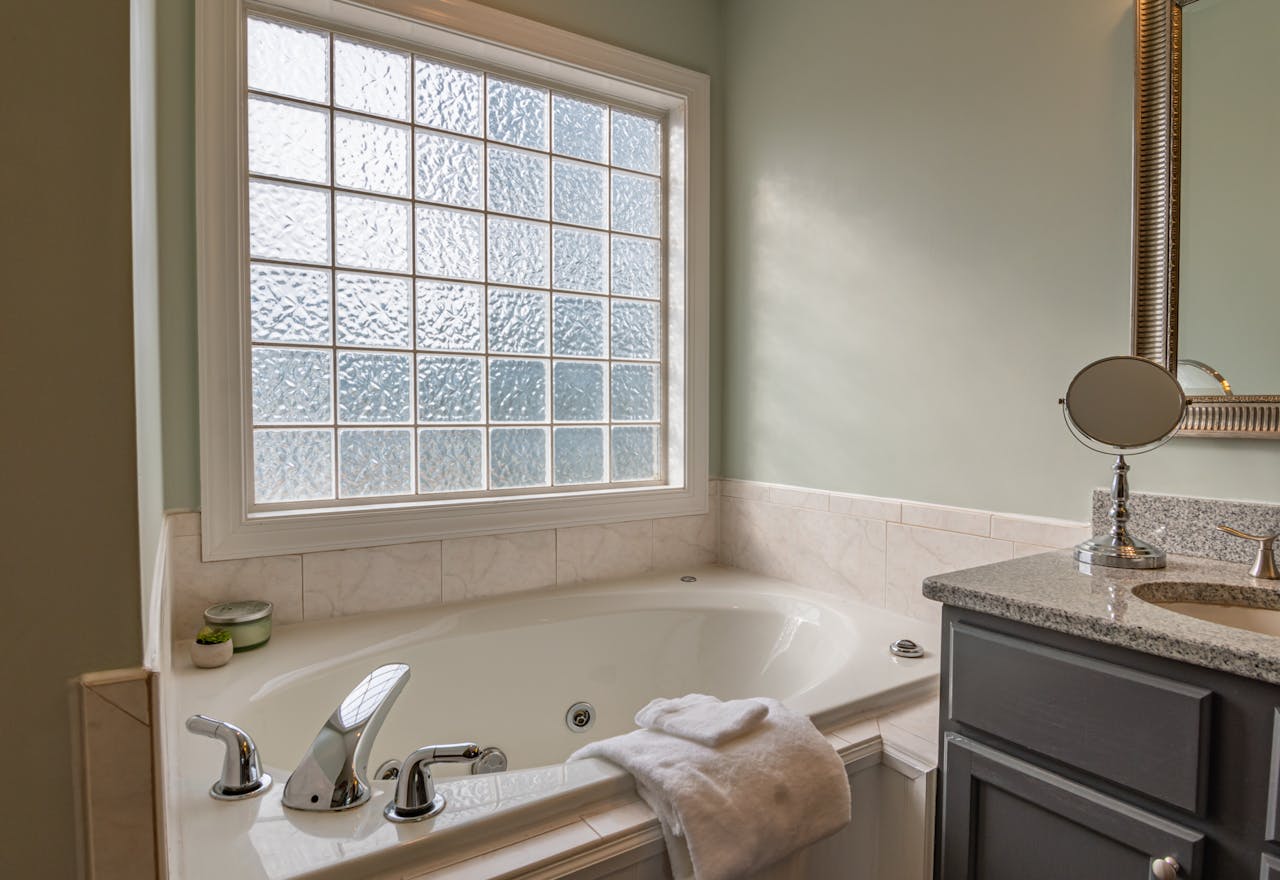
Key Takeaways
- Do start with a detailed plan for your bathroom remodel. By introducing detailed and specific measurements, chosen materials, and a reasonable budget, you can avoid miscommunication and expensive errors.
- Remodel your bathroom around your household’s needs! Day-to-day routines, storage needs, and accessibility should all contribute to making your new space functional and enjoyable.
- Budget realistically by including a 15–20% buffer for unforeseen expenses, closely tracking costs, and avoiding impulse purchases driven by fleeting design trends.
- Ensure ample ventilation and premium waterproofing overall. These steps will help protect against mold, moisture damage, and future costly repairs, important in San Francisco’s typically humid, coastal climate.
- Contract with qualified professionals. Stay in constant communication at every step, never cut corners by avoiding necessary permits and you’ll keep your remodel safe and up to local building codes.
- Choose quality, classic design options that marry function with beauty. Avoid budget materials and trends that won’t hold up to everyday use or provide future value.
What not to do during your bathroom remodeling means knowing the mistakes that can set you back in time and cash.
Whether it’s skipping a design plan, choosing the lowest-quality materials possible, or failing to review San Francisco’s building codes, these mistakes usually result in major headaches.
Ignoring proper vent work or skipping licensed pros will doom your project.
The following pages will walk you through important stages of your renovation. In addition, they’ll point out key items to look for!
Planning Pitfalls: Don’t Start Here
Bathroom remodels in older San Francisco homes take the right planning and craftsmanship. You need more than an idea and a quick trip to the hardware store. Homeowners soon discover problematic design, a lack of funds to complete, and features incompatible with their day-to-day lives. This is what occurs when they don’t have a detailed game plan.
Don’t be afraid to agonize over each decision. From shower size to storage requirements, consider how the space is used, the limitations of local building codes, and the expense of materials in an urban environment.
No Real Blueprint? Big Mistake.
A great home renovation doesn’t begin with scrawls on a cocktail napkin. Detailed blueprints allow architects and designers to collaborate on floor plans, ensuring every project, from sinks to tubs to vanities, right down to the inch.
Trying to squeeze a double vanity into a narrow powder bath, for instance, can result in tight corridors or inconvenient door arcs. Creating a checklist of everything to be included, from tile grout to decorative lighting, and documenting their expected costs ensures nothing is missed in the last-minute scramble.
For instance, in San Francisco, material costs and labor availability can change overnight. To plan for the unknown, factor in a 10–20% contingency into your budget. Well-crafted plans prevent that confusion from ever becoming a concern.
Forgetting How YOU Use It
Just like no two families use a bathroom the same way. Some require additional reverse drawers for skincare storage, whilst others wish to incorporate space for children’s bath toys.
Failing to account for these habits results in a lack of adequate storage or an uncomfortable, cluttered kitchen layout. It’s essential to plan out who uses which spaces, where, and when, right down to towel hooks and cleaning supplies.
Consider access at all times, particularly if anyone within the home will require additional assistance.
“It’ll Be Quick” Famous Last Words
Bathroom renovations never go according toplane. Whether it’s plumbing reroutes, electrical changes, or supply chain hiccups, all of these can stall progress.
When you rush, mistakes happen, like putting the toilets in the wrong place (never across from the entry) or forgetting waterproofing details. Padding your schedule and planning for hiccups, not miracles.

Money Mistakes: Keep Your Wallet Safe
Bathroom remodeling is a complicated endeavor with many moving parts. If you don’t watch all these details with a hawk’s eye, it can get incredibly expensive, incredibly fast! The first step is creating a budget you can stick to. This is a mistake many urban homeowners, especially those in high-cost San Francisco, make all the time.
They not only forget the cost associated with permits and materials. It seems like a no-brainer to shop around for tile, fixtures, and plumbing work before you begin. Yet, almost no one thinks to put in a buffer. It’s hard to predict when a sudden plumbing issue or hidden mold might arise. Repairs can take a huge chunk out of your bank account!
No Buffer? Expect Surprises.
If you think you can add even 15-20% to the amount you’re estimating, that’s not being a genius—it’s a requirement. As an example, unmonitored age pipelines can break at any time. If you do discover water damage underneath the flooring, replacement costs can soar into the thousands!
Monitoring your expenditures in real time helps you identify issues sooner and reallocate funds before it’s too late. Keeping a close eye on your budget every single week allows you to monitor for any overspending, particularly when unplanned setbacks or shortages drive costs higher.
“Too Good To Be True” Deals
Deals that offer low prices on materials are appealing. Something that is very inexpensive like tiles or fixtures usually comes as a red flag for quality. Read reviews, request samples, and consult multiple stores.
In San Francisco, many homeowners have learned the hard way that bad materials or rushed jobs cost more in the long run. A well-built, mid-range product typically provides long-term savings in repair and maintenance costs.
Blowing Budget On Fads
Trendy fixtures or bold designs might seem like the perfect touch today, but they can quickly misfire in terms of longevity. Timeless options and functional designs make it easy to maintain a beautiful, functional space for years to come.
Fancy, high-end features may sound appealing, but only if they meet your specific needs and budget.
My Top Bathroom Remodel No-Nos
A bathroom remodel in San Francisco can offer new life, rejuvenation, and increased happiness. It can increase your property valu,e too! That excitement fizzles fast when minor mistakes turn into major headaches.
The no-no’s listed below are based on my own experience on the job, which outline the most frequently made—and easily missed—mistakes made in today’s bathroom remodels. Here’s an in-depth look at what to avoid at all costs. Each issue is explained in detail so you don’t make the same expensive or aggravating blunder.
1. Ignoring Airflow: Hello Mold!
It’s All About Airflow. Proper airflow is not an afterthought. It’s an essential defense against the persistent fog, moisture, and mildew that Bay Area homes often face due to the local climate.
This is the most common remodel mistake I’ve encountered—failing to size or install an exhaust fan properly. Without it, steamy showers stick around, condensation accumulates, and mold creeps into your corners and grout.
An appropriately-sized exhaust fan, the kind that’s rated for the square footage of your bathroom, will pull out the excess moisture. It’s not as simple as just putting in one and being done.
Bathroom fans require regular maintenance, as lint and dust build-up can quickly clog vents, reducing your fan’s effectiveness. For people in historic homes, increasing airflow through operable windows, when feasible, can provide additional support to maintain indoor air quality.
Cross-ventilation, or using a combination of window and fan, provides even greater protection. Neglecting these steps will result in flaking paint, lingering smells, and a cycle of never-ending fixes.
2. Waterproofing Laziness: Future Ruin
Waterproofing is the unsung hero of any remodel. It’s tempting to take shortcuts or have faith that tile and grout by themselves will stop water. These surfaces aren’t impervious.
San Francisco’s moist environment does nothing to help us from the threat of a slow, stealthy leak and seepage, particularly in showers or around tubs. Utilizing waterproof membranes underneath tile, sealing all seams and joints, and choosing water-resistant backer boards are all vital.
Go big on the tile you use in the showers! Leak-generating surfaces, or high maintenance options, like slippery or porous materials on pans and floors, are the route to ruin. If you’re unsure, it’s wise to hire a pro for this step.
Missed steps or shoddy waterproofing usually show up months down the line in the form of staining, loose tiles, or even structural rot.
3. Botching Plumbing & Drainage
Few things can shorten the life of a remodel quicker than a plumbing disaster. Moving sinks, tubs, or toilets around willy-nilly is unfortunately alluring. Instead, it’s more likely to make a simple task into a logistical nightmare in a matter of seconds!
Not to mention that moving large waste lines in a more established home can be especially difficult. With slab foundations or tight crawlspaces, it’s like doing open-heart surgery on your home!
Clogs, backups, and water hammer usually stem from bad designs or cheap products. Use quality pipes and fittings—low-cost PVC or thin-walled copper rarely last over time.
Always verify code requirements and, for complicated layouts, consult a licensed plumber. Bypassing these steps can result in leaks and expensive remodel tear-outs in the future.
4. Wrong Materials: Constant Headaches
Bathrooms are very unforgiving spaces. Not every surface is suitable for frequent showers, splashes, and heat changes. Untreated wood, porous stone, or even some tiles can warp, stain, or crack quicker than you imagine.
Look for products that are formulated specifically for bathrooms. For instance, strong veining on a marble slab can sink a small space and is prone to staining and etching.
Ask if a particular tile or countertop will require sealing, how often, and what type of maintenance is required. Ignoring this one can result in endless cleaning, repairs or even premature replacement.
5. Forgetting Storage: Clutter Central
A streamlined, minimalist bathroom may be stunning in pictures. Without intelligent storage, the bathroom becomes cluttered quickly with toiletries, towels, and cleaning products, particularly in shared or family environments.
Remodels today are so centered on aesthetics that the functional aspect gets lost. Built-in cabinetry, floating vanities with storage drawers, and open shelves make housekeeping a cinch.
Smart, multifunctional furniture, such as vanities with built-in pull-out organizers, can double your storage without cramping the space. Not only should it be functional, to easily accommodate the everyday habits of all members of the household, but aesthetically pleasing.
6. Awkward Fixtures: Daily Annoyance
Toilet, sink, and shower placement has a big impact on daily comfort. Many remodels forget the small, basic details—like the placement of towel racks and toilet paper holders, leaving awkward spots.
Fixtures jammed too tightly together or installed at strange heights lead to everyday irritations. While building codes in California provide minimum clearances, it’s always a good idea to mock up fixture placements before committing.
For example, if your showerhead is aimed at a glass door, it will spray water all over the place. Further, a vanity set at the wrong height will quickly annoy everyone, especially if they’re all different heights.
It only takes time to measure and mock up placements, but it saves you a heap of regret later.
7. Bad Lighting: Gloomy & Grim
A bathroom where you don’t have to worry about stumbling in the dark is inviting and safe. Bad lighting design is rampant. Just one ceiling fixture will leave you in the dark, in the very spots that require light the most.
This is particularly important when you’re at the mirror or in the shower. A layered approach works best: ambient lighting for general use, task lights above mirrors, and accent lights for mood or highlighting features.
Ensuring the light fixtures provide plenty of brightness for grooming, but don’t flood the area with harshness that it washes out the space. Dimmable options and warm color temperatures, such as 2700K, increase versatility.
8. Not Thinking Long-Term
We don’t want to remodel the bathroom again in five years. Not considering future needs—like the addition of grab bars, wider doorways, or more storage for increasing families—makes costly renovations unavoidable in the future.
In the Bay Area, where homes are highly liquid and often trade, future-proofing becomes a value-added feature. Select durable fixtures and materials that are less likely to stain or break down over time.
Design layouts for the future. With renovations, any adjustment—like replacing a vanity with a pedestal sink or adding a shower bench—shouldn’t mean starting from scratch.
Even better, this kind of forward-thinking saves time, money, and stress when needs inevitably change.
9. Skipping Permits: Risky Business
While permits can be a hassle, they truly serve a purpose. Remodeling without them can lead to fines and forced removal or reselling with issues. Every city in the Bay Area has its code.
San Francisco, as an example, has very stringent regulations concerning plumbing, electrical, and structural work. As with anything, make sure to consult with your local authorities before beginning.
Working with a contractor who’s been around the block a few times makes it all happen and makes getting through inspections a lot easier. Don’t take the chance on all your careful planning going to waste over something as easy to avoid as paperwork.
10. Design Overload: Visual Chaos
It’s so tempting to go overboard with trends. Go too far with the statement features—such as heavy marble veining or contrasting tile patterns—and the space will appear chaotic and claustrophobic.
That same unified design, with a deliberate and limited color palette, plus a few thoughtful focal points, produces an environment that feels serene, sophisticated and enduring.
Avoid overwhelming your space with busy patterns and colors and let balance be your guide. Allow one or two to be the focal point.
For instance, you might consider a statement vanity or an accent wall in lieu of overwhelming the sight with conflicting images. Striking a balance between beauty and everyday function, this method serves the needs of both aesthetics and practicality.
Who’s Doing Work? Avoid Drama
Bathroom remodels in San Francisco can veer off course quickly if you don’t do your due diligence. Plenty of readers have shared stories of rushed jobs, poor choices, and confusion that led to stress and wasted money. By paying attention to who is on your team and how you’re all working together, you can prevent some big headaches from developing.
Hiring Shady Contractors
First, do your homework. Review contractor history and ensure you get contractor references—actual references, not names. Those who haven’t learned the hard way should be warned—a smooth talker is not always a good builder.
Evaluate at least three proposals in detail. Some folks found lower bids hid cut corners, like skipping proper waterproofing, which later caused mold to creep up fresh paint. Don’t ignore your gut instincts. If you get a bad vibe, move on to another candidate.
A reader shared how ignoring an uneasy feeling about a contractor led to constant delays and shoddy tile work that felt cold and looked grimy right away.
Radio Silence with Your Crew
Step 4—Avoid drama, stay communicative. Keep those lines of communication open. Build in regular check-ins to go over modifications. Correct problems, such as the platform floor that one homeowner found frightening.
Open up strong channels—text, email, or a Google Doc. group By doing so, no one is ever left in the dark about timelines. They can provide input on more granular design changes, including rearranging space from a bedroom closet to create a master bath.
Be clear about what is decided and why. Misunderstandings, like a badly angled shower that douses you with ice water, frequently arise from a lack of attention to the finer points of dialogue.
DIY Dreams Turn Disastrous
Know your creative limits and be upfront about lack of experience. Projects that are overly ambitious, such as tiling or plumbing, can result in uneven floors or leaky fixtures.
Others needed to bring in professionals after DIY projects turned perfectly white grout lines deep shades of dark and moldy. If you know your work isn’t the best, enlist third-party assistance before issues escalate.

Style & Stuff: Choices You’ll Regret
Bathroom remodeling in the Bay Area and other urban markets often pulls from both the style and functional buckets. It’s very easy to get caught up in aesthetics or fashions and lose sight of what’s important. Below, we walk through some decisions that users of all levels often regret, with real-world, practical examples rooted in everyday use.
Chasing Trends You’ll Hate
We’ve mentioned before that many remodels in San Francisco have open showers or rain showerheads, influenced by upscale hotels. Her local climate, which frequently doesn’t get over 50 degrees, meant that open showers were cold and unfeasible.
Trendy, oversized rain heads may be all the rage, but homeowners quickly discover they’re impractical if they don’t take a shower every day. Multi-headed steam showers are beautiful to behold, but most people don’t use them often enough.
Timeless tile patterns and understated fixtures stand the test of time and will increase resale value. Strong, trendy aesthetics can date a project in a heartbeat.
Cheap Materials Cost More Later
While it pays to take materials shortcuts up front, nothing is more aggravating than cutting corners later. Flat matte paint in a heavy-use bathroom highlights every fingerprint and is nearly impossible to wipe down.
Cream grout looks crisp initially, but cleaning it is a daily struggle. Huge tubs feel indulgent, but if your water heater can’t fill one up, it just becomes a space-hogging liability.
Consider the ROI on higher-quality tile, hardware, and fixtures that are more durable and require lower maintenance.
Forgetting Its Core Purpose
Foremost, the purpose of a bathroom should be utility and relaxation. Poorly thought out locations for towel bars or toilet paper dispensers can make you cringe every time you go in there.
Tubs that are too large to fill, toilets squeezed into an awkward corner, or inflexible showerheads all lead to an unpleasant and less accessible experience. Everything we’ve learned indicates that good design begins with the intended use of the room—not the aesthetic appearance of it.
Conclusion
Avoid the trial and error in your bath renovation. Have a well-defined vision, avoid budget creep, and hire a quality team to accomplish the plan. Poor preparation or taking shortcuts results in leaks, cracked tiles, and a nightmare no one wants. Overlooking necessary permits can bring the whole project to a halt. Inadequate lighting and bizarre fixtures will adversely affect your home’s value, beyond aesthetics alone. Consider how your space functions for everyday use, rather than focusing solely on aesthetics. In San Francisco, where vintage plumbing and cramped quarters add pressure to every detail, that’s especially true. Rely on local pros and communicate openly with your crew. Communication is key when it comes to remodeling. Have remodel experiences or advice to share? Leave ’em in the comments and spare others from making the same mistake.
Frequently Asked Questions
1. What Is The Biggest Planning Mistake In A Bathroom Remodel?
What is the biggest planning mistake in a bathroom remodel? Without a cohesive design in place and proper timeline, projects exceed budgets or are pushed back. The way to avoid this mistake is simple—plan your layout and materials!
2. How Can I Avoid Overspending On My Bathroom Remodel?
How can I avoid overspending on my bathroom remodel? Obtain several estimates from area San Francisco remodelers, and budget an additional 10–15% for surprises. Keep a record of every cost.
3. Why Shouldn’t I Move Plumbing During A Remodel?
Moving plumbing is not only expensive but usually unnecessary. For example, in San Francisco, many homes older than 100 years have very old, very problematic pipes. Only relocate plumbing if necessary for your new layout.
4. Should I Hire A General Contractor Or Do It Myself?
Unless you have experience, hire a licensed professional contractor. Many DIY mistakes are even more expensive to fix. As anyone who has done a remodel in the Bay Area knows, permits and codes are very strict here, making professional help essential.
5. What Bathroom Trends Should I Avoid?
In other words, if you choose trendy tiles or colors, they might become outdated in no time. Resale value is highest when you stick to classic, timeless styles. When in doubt, creamy palettes and classic fixtures are a sure-fire favorite in San Francisco.
6. How Can I Make Sure My Remodel Passes Inspection?
Partner with licensed professionals that are well-versed with local codes. Make sure to always pull the appropriate permits for your project in San Francisco to avoid expensive fines or redoing work.
7. What Materials Should I Avoid In A Foggy, Coastal Climate Like San Francisco?
Avoid materials that aren’t moisture-friendly, such as low-grade laminate. Select porcelain, ceramic, or natural stone. These are the most fog-resistant materials in our city’s humid, coastal climate.
Your Dream Bathroom Starts With Mares & Dow Construction – Let’s Build A Beautiful Space Together
Thinking about a bathroom remodel in Concord, Walnut Creek, Pleasant Hill, or Lafayette? Whether you’re envisioning a luxurious spa-like retreat or a smart, space-saving update, choosing the right contractor is the most important step in turning your vision into reality.
With over 40 years of proven experience, the team at Mares & Dow Construction & Skylights is trusted throughout Contra Costa County for expert craftsmanship, transparent pricing, and outstanding customer service. We specialize in:
- Bathroom Remodeling – Upgrade your outdated bathroom into a stylish, functional, and energy-efficient space. From elegant tilework and modern fixtures to walk-in showers and custom vanities, we handle every detail with precision.
- Decks and Outdoor Living Spaces – Extend your home’s living space with beautifully designed decks, patios, and pergolas built to last.
- Foundation Repairs and Waterproofing – Protect your home from moisture and structural damage with our reliable repair and waterproofing services.
- Custom Skylight Installations – Brighten your bathroom naturally with premium skylight solutions installed by a certified VELUX 5-Star Skylight Specialist.
- General Contracting Services – From bathroom renovations to larger home improvement projects, we manage every aspect with the highest standards in the industry.
Proudly serving Alamo, Danville, Orinda, Martinez, San Ramon, and the surrounding areas, Mares & Dow Construction & Skylights is committed to delivering exceptional results. Whether you’re a homeowner upgrading your primary bathroom or an investor modernizing a property, we ensure your remodel is completed on time, within budget, and with superior quality.
Don’t trust your bathroom remodel to just anyone. Contact Mares & Dow Construction & Skylights today for a free, no-obligation consultation, and let’s turn your bathroom into a space you love.
Disclaimer
The materials available on this website are for informational and educational purposes only and are not intended to provide construction, legal, or professional advice. You should consult with a qualified general contractor or industry professional for advice concerning any specific construction project, remodeling plan, or structural concern. Do not act or refrain from acting based on any content included on this site without seeking appropriate professional guidance. The information presented on this website may not reflect the most current building codes, regulations, or industry best practices. No action should be taken in reliance on the information on this website. We disclaim all liability for actions taken or not taken based on any or all of the contents of this site to the fullest extent permitted by law.





 based on
based on 

